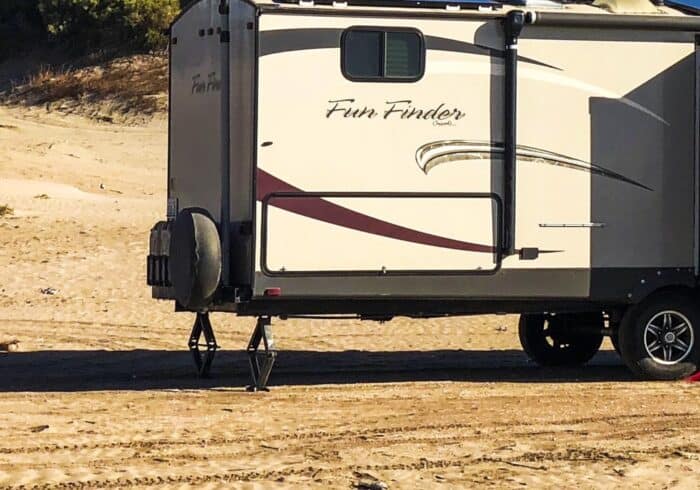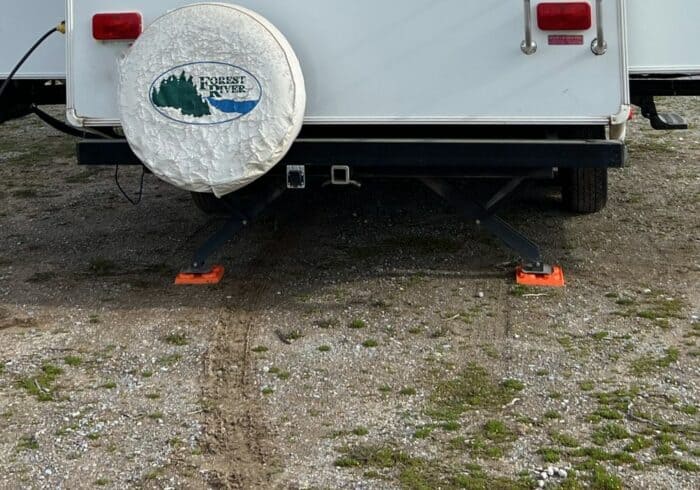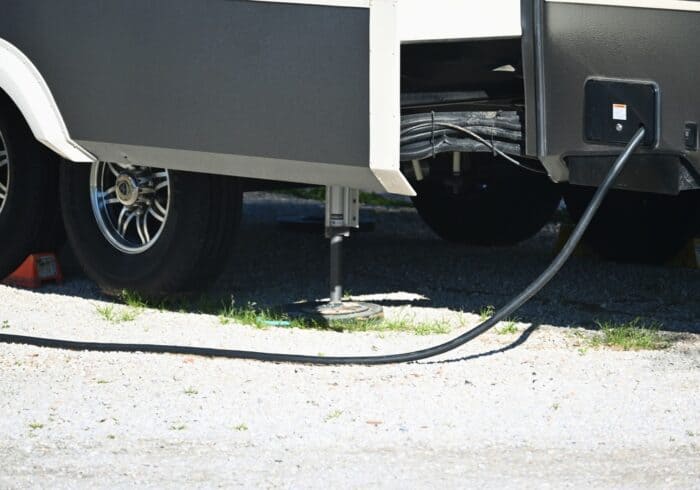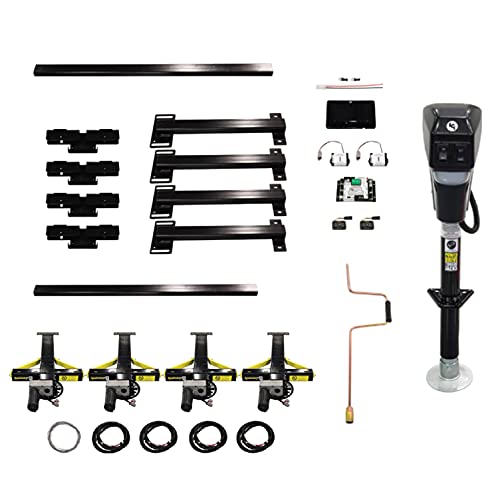What’s the Difference Between Stabilizer and Leveling Jacks?
There has always been a little confusion surrounding RV stabilizer and leveling jacks.
Because they are both a kind of jack it’s easy to think that they work the same way and can do the same things, but they really aren’t the same at all.
Related Product: We level our RV with the innovative Andersen RV Leveling Set (click to view on Amazon)
A stabilizer jack on an RV is used to help stop it from moving around when someone is inside or the wind is blowing.
They are not meant to take the full weight of an RV.
Leveling jacks are used to lift the entire weight of an RV.
You cannot use a stabilizer jack to lift or level an RV.
See Also: What Is The Best RV Stabilizer System?
What Does an RV Stabilizer Jack Look Like?
There are two main kinds of RV stabilizer jacks manual crank scissor jacks (click to view on Amazon).

And C-jacks (click to view on Amazon) that can be either electric or manual.

I think the confusion between camper stabilizers and leveling jacks happens when people see the manual crank scissor jacks on their RV.
They look a lot like the little emergency jacks in some vehicles that are made to lift cars for changing tires.
So why don’t RV stabilizer jacks work the same way?
While scissor jacks are by design a very strong jack that can take a lot of weight the placement is the biggest issue when it comes to lifting an RV.
Stabilizer jacks are normally near the far corners of campers, and the corner is not where you want to place a jack when you lift an RV.
See Also: Best RV Stabilizers For RV, 5th-Wheel & Travel Trailer
If you’re going to change a tire on your RV always place the jack either under the axel or as close to the tires as possible on the frame.
Because of the placement on the frame if you lift your RV with the stabilizer jacks and start walking around in your camper you risk damaging the jack and the frame of the camper.
Most RVs are built as fast as possible in large factories and they are often built for quantity over quality.
Tension in the wrong spot could cause a weld to break or a piece of the frame to twist.
Scissor jacks also have weight ratings and since they are not supposed to lift an RV they can be rated for a lighter weight than what the camper actually is.
If the jack gets bent or damaged it won’t be lifting your RV anymore and it might even get stuck in an open position.
Which means it will have to be removed before you can get on the road again.
Why Do RVs Have Stabilizer Jacks?
RV stabilizer jacks sound pretty useless but they actually help reduce the movement of parked RVs quite a bit.
They’re especially nice if your camper has slide outs.
Since RVs are on a suspension system that’s made to bounce around so the frame of the camper doesn’t take any unnecessary strain when driving, they never stop moving, even when parked.
Stabilizer jacks help stop the suspension system from bouncing so you don’t shake the RV like crazy when walking around inside.
See Also: Best RV Wheel Chocks (Plastic, Rubber, Metal, X-Chock)
It also helps reduce a camper’s movement in the wind so you don’t get seasick just from sitting inside.
While RV stabilizer jacks do help they aren’t 100% effective.
There will always be some movement but they really are a good way to stabilize as much as possible without having to lift the entire RV.
With that being said they don’t work nearly as well as leveling jacks, which I’ll talk about next.
What Does an RV Leveling Jack Look Like?
RV leveling jacks are thick poles that extend straight down. They usually use a motorized gear system or are hydraulic.
They are most commonly found on the front of travel trailers and 5th wheels.
On travel trailers, the leveling jack is the front a-frame/tongue jack (click to view on Amazon) that you use to lift the camper for hitching and unhitching.
On 5th-wheels they are what’s called the landing gear (click to view on Amazon).
Every 5th-wheel has two leveling jacks in the front lower corners that are used to “land” the trailer.
Much like the tongue jacks, they are also used for hitching and unhitching.
In addition to lifting for hitching up these jacks are also used to level camper trailers from front to back.
They also help stabilize since they are a solid connection between the camper and the ground.
Unlike stabilizer jacks, they are placed in strategic spots where the frame can handle the weight of the camper.
See Also: Why Is It Important To Level Your RV?
Back in the day, these were the only kinds of leveling jacks you would see on trailers. And there weren’t leveling jacks put on many motorhomes.
But since they are way more effective than RV stabilizer jacks, RV manufacturers are starting to put leveling jacks on more than just the front of camper trailers.
Today, many motorhomes have automatic leveling systems that include 4 leveling jacks. Two behind the front tires and two behind the rear tires.
They are placed so the entire motorhome can be lifted without damaging the frame.
If you’ve ever walked around a campground and seen a Class A motorhome with one of the tires completely lifted off the ground you know that they have an automatic leveling system.
The same kind of leveling jacks (click to view on Amazon) are being added to 5th-wheels and travel trailers.

They are usually placed directly behind the rear tires and they eliminate the need for stabilizer jacks.
It’s usually the biggest toy haulers and 5th-wheels that have them but they can be added to travel trailers as well.
Can RV Leveling Jacks Be Added To RVs?
If you’re tired of the movement that RV stabilizer jacks allow, or you want to be able to get level at a campsite faster there are leveling jack kits you can get for both travel trailers and 5th-wheels.
Lippert Ground Control 3.0 5th-Wheel Auto Leveling System
If you want to go all the way and upgrade your 5th-wheel to a fully automatic leveling system, this is the kit you are going to want.
It comes with everything you need to level your RV with just the press of a button.
You get two new landing gear front jacks and two rear leveling jacks.
All of them are connected with a central control panel that will extend each jack individually until the RV is fully level.
You can also use the same control panel to extend or retract each RV leveling jack individually.
See Also: Best 5th Wheel Hitches (Reese, B&W, Curt, Andersen, Blue Ox)
The first requirement for this system is that your 5th-wheel has a GVWR of 15,500 or less.
Second, the distance between the front landing gear jacks and the spot the jack will be installed behind the back tire also matters.
If the distance is less than 20 feet you can use the 4-point system linked to above.
If the distance is more than 20 feet you will need this 6-point system (click to view on Amazon).
Note that the 6-point system does not have a higher weight capacity.
Lippert Ground Control Travel Trailer Automatic Leveling System
Some travel trailers have RV leveling jacks that are similar to the Lippert 5th-wheel ones reviewed above but there is also a system made specifically for travel trailers.
Oddly enough it uses C jacks that look a lot like the electric stabilizer jacks commonly found on 5th-wheels and high end travel trailers.
The main difference between these is that there are 4 individual C jacks and not two connected like with the stabilizer version.
See Also: Best Weight Distribution Hitches With Sway Control
Also, these are more heavy duty with larger motors and feet.
If you install these leveling jacks on your travel trailer you may have some fellow campers commenting that you are using your stabilizer jacks wrong but these are made to level and lift an RV.
The main requirement is that your travel trailer has a GVWR of 10,000 lbs or less.
Have any questions about using stabilizer jacks to lift or level an RV? Leave a comment below.



